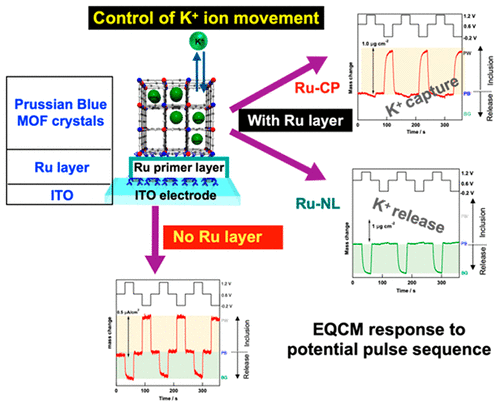当前位置:
X-MOL 学术
›
ACS Appl. Electron. Mater.
›
论文详情
Our official English website, www.x-mol.net, welcomes your
feedback! (Note: you will need to create a separate account there.)
Regulation of Ion Transport in Prussian Blue MOF Films by a Ru-Complex Primer Nanolayer on an ITO Electrode and Its Energy Storage Application
ACS Applied Electronic Materials ( IF 4.3 ) Pub Date : 2021-09-02 , DOI: 10.1021/acsaelm.1c00514 Mitsutoshi Ide 1 , Hiroaki Sato 1 , Hiroaki Ozawa 1 , Masa-aki Haga 1
ACS Applied Electronic Materials ( IF 4.3 ) Pub Date : 2021-09-02 , DOI: 10.1021/acsaelm.1c00514 Mitsutoshi Ide 1 , Hiroaki Sato 1 , Hiroaki Ozawa 1 , Masa-aki Haga 1
Affiliation

|
The control of ion and electron transport (ET) by external stimuli in redox-active crystals of Prussian blue (PB), a well-known nanoporous metal–organic framework (MOF), is key to the development of PB-based electronic and energy devices. To achieve ion storage and release in PB nanopores, thin layers of redox-active Ru complexes were inserted as a primer layer between an indium tin oxide (ITO) electrode and a PB film for electrochemical interfacing. On unmodified ITO electrodes, PB films can be oxidized to Berlin Green (BG) and reduced to Prussian White (PW) via two-step processes. However, the Ru-complex-modified heterolayer films ITO||(Ru-complex)3/(PB) exhibited only one redox process, i.e., either PB/PW or BG/PB, due to the ET rectification between the PB and the Ru complex, which depends on the redox potential of the Ru complex. Electrochemical quartz crystal microbalance (EQCM) measurements indicated that the storage/release of K+ ions in the PB nanopores is gated by the redox potential of the Ru-complex primer layer. The slower rate of ion transport relative to ET leads to a large hysteresis loop on EQCM, which can be exploited to develop ion storage memory devices. Additionally, a K+ ion rocking-chair-type asymmetric redox capacitor was constructed by combining two ITO||(Ru-complex)3/(PB) films. The electrochemical interfacing of redox-active PB MOF crystals on the heterojunction electrode surface can thus be expected to open new possibilities for charge storage via the regulation of ion transport in the PB-based devices.
中文翻译:

ITO电极上Ru复合底漆纳米层对普鲁士蓝MOF薄膜中离子传输的调控及其储能应用
普鲁士蓝 (PB) 是一种著名的纳米多孔金属有机骨架 (MOF) 氧化还原活性晶体,通过外部刺激控制离子和电子传输 (ET) 是开发基于 PB 的电子和能量的关键设备。为了在 PB 纳米孔中实现离子存储和释放,氧化还原活性 Ru 复合物的薄层被插入作为底漆层在氧化铟锡 (ITO) 电极和用于电化学接口的 PB 膜之间。在未改性的 ITO 电极上,PB 膜可以通过两步法氧化成柏林绿 (BG) 并还原成普鲁士白 (PW)。然而,Ru-络合物改性的异质层薄膜 ITO||(Ru-complex) 3/(PB) 仅表现出一种氧化还原过程,即 PB/PW 或 BG/PB,这是由于 PB 和 Ru 配合物之间的 ET 整流,这取决于 Ru 配合物的氧化还原电位。电化学石英晶体微量天平 (EQCM) 测量表明,PB 纳米孔中 K +离子的存储/释放受 Ru 复合底漆层的氧化还原电位控制。相对于 ET 较慢的离子传输速率导致 EQCM 上的大滞后回线,可用于开发离子存储存储设备。此外,通过结合两个ITO||(Ru-complex) 3构建了K +离子摇椅型不对称氧化还原电容器/(PB) 薄膜。因此,异质结电极表面上氧化还原活性 PB MOF 晶体的电化学界面有望通过调节 PB 器件中的离子传输为电荷存储开辟新的可能性。
更新日期:2021-09-28
中文翻译:

ITO电极上Ru复合底漆纳米层对普鲁士蓝MOF薄膜中离子传输的调控及其储能应用
普鲁士蓝 (PB) 是一种著名的纳米多孔金属有机骨架 (MOF) 氧化还原活性晶体,通过外部刺激控制离子和电子传输 (ET) 是开发基于 PB 的电子和能量的关键设备。为了在 PB 纳米孔中实现离子存储和释放,氧化还原活性 Ru 复合物的薄层被插入作为底漆层在氧化铟锡 (ITO) 电极和用于电化学接口的 PB 膜之间。在未改性的 ITO 电极上,PB 膜可以通过两步法氧化成柏林绿 (BG) 并还原成普鲁士白 (PW)。然而,Ru-络合物改性的异质层薄膜 ITO||(Ru-complex) 3/(PB) 仅表现出一种氧化还原过程,即 PB/PW 或 BG/PB,这是由于 PB 和 Ru 配合物之间的 ET 整流,这取决于 Ru 配合物的氧化还原电位。电化学石英晶体微量天平 (EQCM) 测量表明,PB 纳米孔中 K +离子的存储/释放受 Ru 复合底漆层的氧化还原电位控制。相对于 ET 较慢的离子传输速率导致 EQCM 上的大滞后回线,可用于开发离子存储存储设备。此外,通过结合两个ITO||(Ru-complex) 3构建了K +离子摇椅型不对称氧化还原电容器/(PB) 薄膜。因此,异质结电极表面上氧化还原活性 PB MOF 晶体的电化学界面有望通过调节 PB 器件中的离子传输为电荷存储开辟新的可能性。











































 京公网安备 11010802027423号
京公网安备 11010802027423号